Secretariat of ISO/TC 176/SC 2 Date: 3 June
2013
To the Members of
ISO/TC 176/SC 2 -
Quality Management and
Quality Assurance/
Quality Systems
ISO/CD 9001
目录
1 Scope 范围
2 Normative references 规范性引用文件
3 Terms and definitions 术语和定义
4 Context of the organization 组织的背景
4.1 Understanding the organization and its context理解组织及其背景
4.2 Understanding the needs and expectations of interested parties理解相关方的需求和期望
4.3 Determining the scope of the quality management system质量管理体系范围的确定
4.4 Quality management system 质量管理体系
5 Leadership 领导作用
5.1 Leadership and commitment 领导作用和承诺
5.2 Quality policy 质量方针
5.3 Organizational roles, responsibilities and authorities组织的作用、职责和权限
6 Planning 策划
6.1 Actions to address risks and opportunities 风险和机遇的应对措施
6.2 Quality objectives and planning to achieve them质量目标及其实施的策划
6.3 Planning of changes 变更的策划
7 Support 支持
7.1 Resources 资源
7.2 Competence 能力
7.3 Awareness 意识
7.4 Communication 沟通
7.5 Documented information 形成文件的信息
8 Operation 运行
8.1 Operational planning and control 运行的策划和控制
8.2 Determination of market needs and interactions with customers 市场需求的确定和顾客沟
通
8.3 Operational planning process 运行策划过程
1
�
8.4 Control of external provision of goods and services外部供应产品和服务的控制
8.5 Development of goods and services 产品和服务开发
8.6 Production of goods and provision of services 产品生产和服务提供
8.7 Release of goods and services 产品和服务放行
8.8 Nonconforming goods and services 不合格产品和服务
9 Performance evaluation 绩效评价
9.1 Monitoring, measurement, analysis and evaluation监视、测量、分析和评价
9.2 Internal Audit 内部审核
9.3 Management review 管理评审
10 Continual improvement 持续改进
10.1 Nonconformity and corrective action 不符合和纠正措施
10.2 Improvement 改进附录
A Annex A Quality management principles (Informative)质量管理原则文献
1.Scope 范围
This International Standard specifies requirements for a quality management system where
an organization 本标准为有下列需求的组织规定了质量管理体系要求:
a)needs to demonstrate its ability to consistently provide goods and services that meet
customer and applicable statutory and regulatory requirements, and 需要证实其具有稳定地提
供满足顾客要求和适用法律法规要求的产品和服务的能力;
b)aims to enhance customer satisfaction through the effective application of the system,
including processes for continual improvement of the system and the assurance of conformity to
customer and applicable statutory and regulatory requirements通过体系的的有效应用,包括体
系持续改进的过程,以及保证符合顾客和适用的法律法规要求,旨在增强顾客满意。
注 1:In this International Standard, the term “product” only applies to 在本标准一中,术语“产
品”仅适用于:
a) goods and services intended for, or required by, a customer, and预期提供给顾客或顾客
所要求的商品和服务;
b) any intended output resulting from the operational processes 运行过程所产生的任何预
期输出。
注 2:Statutory and regulatory requirements can be expressed as legal requirements法律法规要
求可称作为法定要求。
2 Normative references 规范性引用文件
The following referenced documents are indispensable for the application of this document.
For dated references, only the edition cited applies. For undated references, the latest edition of
the referenced document (including any amendments) applies下列文件中的条款通过本标准的
引用而构成本标准的条款。凡是注日期的引用文件,只有引用的版本适用。凡是不注日期的
引用文件,其最新版本(包括任何修订)适用于本标准。
ISO 9000:2015, Quality management systems — Fundamentals and vocabulary
GB/T19000-2015 质量管理体系 基础和术语
2
�
3 Term and definitions术语和定义
For the purposes of this document, the terms and definitions given in ISO 9000 apply 本标准
采用 GB/T19000 中所确立的术语和定义。
4 Context of the organization 组织的背景环境
4.1 Understanding the organization and its context 理解组织及其背景环境
The organization shall determine external and internal issues, that are relevant to its purpose
and its strategic direction and that affect its ability to achieve the intended outcome(s) of its
quality management system 组织应确定外部和内部那些与组织的宗旨、战略方向有关、影响
质量管理体系实现预期结果的能力的事务。
The organization shall update such determinations when needed 需要时,组织应更新这些
信息。
When determining relevant external and internal issues, the organization shall consider
those arising from:在确定这些相关的内部和外部事宜时,组织应考虑以下方面:
a) changes and trends which can have an impact on the objectives of the organization可能对组
织的目标造成影响的变更和趋势;
b) relationships with, and perceptions and values of relevant interested parties与相关方的关系,
以及相关方的理念、价值观;
c) governance issues, strategic priorities, internal policies and commitments; and组织管理、战略
优先、内部政策和承诺;
d) resource availability and priorities and technological change资源的获得和优先供给、技术变
更。
注 1:Understanding the external context can be facilitated by considering issues arising from
legal, technological, competitive, cultural, social, economic and natural environment, whether
international, national, regional or local. 外部的环境,可以考虑法律、技术、竞争、文化、社
会、经济和自然环境方面,不管是国际、国家、地区或本地。
注 2:When understanding the internal context the organization could consider those related to
perceptions, values and culture of the organization.内部环境,可以组织的理念、价值观和文化。
4.2 Understanding the needs and expectations of interested parties理解相关方的需求和期望
The organization shall determine 组织应确定:
a) the interested parties that are relevant to the quality management system, and 与质量管理体
系有关的相关方
b) the requirements of these interested parties相关方的要求
The organization shall update such determinations in order to understand and anticipate
needs or expectations affecting customer requirements and customer satisfaction 组织应更新以
上确定的结果,以便于理解和满足影响顾客要求和顾客满意度的需求和期望。
The organization shall consider the following relevant interested parties 组织应考虑以下相
关方:
a) direct customers 直接顾客
3
�
b) end users 最终使用者
c) suppliers, distributors, retailers or others involved in the supply chain 供应链中的供方、分销
商、零售商及其他
d) regulators; and 立法机构
e) any other relevant interested parties其他
注:Note Addressing current and anticipated future needs can lead to the identification of improvement and
innovation opportunities 应对当前的和预期的未来需求可导致改进和变革机会的识别。
4.3 Determining the scope of the quality management system确定质量管理体系的范围
The organization shall determine the boundaries and applicability of the quality management
system to establish its scope 组织应界定质量管理体系的边界和应用,以确定其范围。
When determining this scope, the organization shall consider在确定质量管理体系范围时,组织
应考虑:
a) the external and internal issues referred to in 4.1, and 标准 4.1 条款中提到的内部和外部事
宜
b) the requirements referred to in 4.2 标准 4.2 条款的要求
The scope shall be stated in terms of goods and services, the main processes to deliver them and
the sites of the organization included 质量管理体系的范围应描述为组织所包含的产品、服务、
主要过程和地点。
When stating the scope, the organization shall document and justify any decision not to apply a
requirement of this International Standard and to exclude it from the scope of the quality
management system. Any such exclusion shall be limited to clause 7.1. 4 and 8 and shall not
affect the organization’s ability or responsibility to assure conformity of goods and services and
customer satisfaction, nor can an exclusion be justified on the basis of a decision to arrange for
an external provider to perform a function or process of the organization. 描述质量管理体系的
范围时,对不适用的标准条款,应将质量管理体系的删减及其理由形成文件。删减应仅限于
标准第 7.1、4 和 8 章节,且不影响组织确保产品和服务满足要求和顾客满意的能力和责任。
过程外包不是正当的删减理由。
注:An external provider can be a supplier or a sister organization (such as a headquarters or alternate site
location) that is outside of the organization ’s quality management system. 外部供应商可以是组织质量管
理体系之外的供方或兄弟组织。
The scope shall be available as documented information质量管理管理体系范围应形成文件。
4.4 Quality management system 质量管理体系
4.4.1 General 总则
lly improve a quality
The organization shall establish, implement, maintain and continua
management system, including the processes needed and their interactions, in accordance with
the requirements of this International Standard.组织应按本标准的要求建立质量管理体系、过
程及其相互作用,加以实施和保持,并持续改进。
4.4.2 Process approach 过程方法
The organization shall apply a process approach to its quality management system. The
4
�
organization shall:组织应将过程方法应用于质量管理体系。组织应:
a) determine the processes needed for the quality management system and their application
throughout the organization;确定质量管理体系所需的过程及其在整个组织中的应用;
b) determine the inputs required and the outputs expected from each process; 确定每个过程所
需的输入和期望的输出;
c) determine the sequence and interaction of these processes; 确定这些过程的顺序和相互作
用;
d) determine the risks to conformity of goods and services and customer satisfaction if
unintended outputs are delivered or process interaction is ineffective; 确定产生非预期的输出
或过程失效对产品、服务和顾客满意带来的风险;
e) determine criteria, methods, measurements, and related performance indicators needed to
ensure that both the operation and control of these processes are effective确定所需的准则、方
法、测量及相关的绩效指标,以确保这些过程的有效运行和控制;
f) determine the resources and ensure their availability确定和提供资源;
g) assign responsibilities and authorities for processes规定职责和权限;
h) implement actions necessary to achieve planned results实施所需的措施以实现策划的结果;
i) monitor, analyse and change, if needed, these processes ensuring that they continue to deliver
the intended outputs; and 监测、分析这些过程,必要时变更,以确保过程持续产生期望的结
果;
j) ensure continual improvement of these processes.确保持续改进这些过程。
5 Leadership 领导作用
5.1Leadership and commitment 领导作用与承诺
5.1.1 Leadership and commitment with respect to the quality management system针对质量管
理体系的领导作用与承诺
Top management shall demonstrate leadership and commitment with respect to the quality
management system by 最高管理者应通过以下方面证实其对质量管理体系的领导作用与承
诺:
a) ensuring that quality policies and quality objectives are established for the quality
management system and are compatible with the strategic direction of the organization; 确保质
量方针和质量目标得到建立,并与组织的战略方向保持一致;
b) ensuring the quality policy is understood and followed within the organization; 确保质量方针
在组织内得到理解和实施;
c) ensuring the integration of the quality management system requirements into the
organization’s business processes;确保质量管理体系要求纳入组织的业务运作;
d) promoting awareness of the process approach;提高过程方法的意识;
e) ensuring that the resources needed for the quality management system are available;确保质量
管理体系所需资源的获得;
f) communicating the importance of effective quality management and of conforming to the
quality management system requirements and the requirements of goods and services;传达有效
的质量管理以及满足质量管理体系、产品和服务要求的重要性;
g) ensuring that the quality management system achieves its intended outcomes outputs;确保质
量管理体系实现预期的输出;
h) engaging, directing and supporting persons to contribute to the effectiveness of the quality
5
�
management system 吸纳、指导和支持员工参与对质量管理体系的有效性作出贡献;
i) promoting continual improvement and innovation ; and 增强持续改进和创新;
j) supporting other relevant management roles to demonstrate their leadership as it applies to
their areas of responsibility.支持其他的管理者在其负责的领域证实其领导作用。
5.1.2Leadership and commitment with respect to the needs and expectations of customers 针
对顾客需求和期望的领导作用与承诺
Top management shall demonstrate leadership and commitment with respect to customer focus
by ensuring that 最高管理者应通过以下方面,证实其针对以顾客为关注焦点的领导作用和承
诺:
a) the risks which can affect conformity of goods and services and customer satisfaction are
identified and addressed;可能影响产品和服务符合性、顾客满意的风险得到识别和应对;
b) customer requirements are determined and met;顾客要求得到确定和满足;
c) the focus on consistently providing goods and services that meet customer and applicable
statutory and regulatory requirements is maintained;保持以稳定提供满足顾客和相关法规要求
的产品和服务为焦点;
d) the focus on enhancing customer satisfaction is maintained;保持以增强顾客满意为焦点;
注:Reference to “business” in this International Standard should be interpreted broadly to mean those activities
that are core to the purposes of the organization ’s existence.本标准中的“业务”可以广泛地理解为对组
织存在的目的很重要的活动。
5.2Quality policy 质量方针
Top management shall establish a quality policy that:最高管理者应制定质量方针,方针应:
a) is appropriate to the purpose of the organization;与组织的宗旨相适应;
b) provides a framework for setting quality objectives;提供制定质量目标的框架;
c) includes a commitment to satisfy applicable requirements, and包括对满足适用要求的承诺;
d) includes a commitment to continual improvement of the quality management system. 包括对
持续改进质量管理体系的承诺。
The quality policy shall:质量方针应:
a) be available as documented information;形成文件;
b) be communicated within the organization;在组织内得到沟通;
c) be available to interested parties, as appropriate; and适用时,可为相关方所获取;
d) be reviewed for continuing suitability.在持续适宜性方面得到评审。
注:Quality Management Principles can be used as the basis for the quality policy.质量管理原则可作为质量
方针的基础。
5.3 Organizational roles, responsibilities and authorities组织的作用、职责和权限
Top management shall ensure that the responsibilities and authorities for relevant roles are
assigned and communicated within the organization.最高管理者应确保组织内相关的职责、权
限得到规定和沟通。
6
�
Top management shall be accountable for the effectiveness of the quality management system
and shall assign the responsibility and authority for: 最高管理者应对质量管理体系的有效性负
责,并规定职责和权限以便:
a) ensuring that the quality management system conforms to the requirements of this
International Standard and,确保质量管理体系符合本标准的要求;
b) ensuring that the processes interact and are delivering their intended outputs; 确保过程相互
作用并产生期望的结果;
c) reporting on the performance of the quality management system to top management and any
need for improvement, and 向最高管理者报告质量管理体系的绩效和任何改进的需求;
d) ensuring the promotion of awareness of customer requirements throughout the organization.
确保在整个组织内提高满足顾客要求的意识。
6 Planning 策划
6.1Actions to address risks and opportunities 风险和机遇的应对措施
When planning for the quality management system, the organization shall consider the issues
referred to in 4.1 and the requirements referred to in 4.2 and determine the risks and
opportunities that need to be addressed to 策划质量管理体系时,组织应考虑 4.1 和 4.2 的要
求,确定需应对的风险和机遇,以便:
a) assure the quality management system can achieve its intended outcome(s); 确保质量管理体
系实现期望的结果;
b) assure that the organization can consistently achieve conformity of goods and services and
customer satisfaction;确保组织能稳定地实现产品、服务符合要求和顾客满意;
c) prevent, or reduce, undesired effects, and预防或减少非预期的影响;
d) achieve continual improvement.实现持续改进。
The organization shall plan:组织应策划:
a) actions to address these risks and opportunities, and风险和机遇的应对措施;
b) how to 如何
1) integrate and implement the actions into its quality management system processes (see 4.4),
and 在质量管理体系过程中纳入和应用这些措施(见 4.4)
2) evaluate the effectiveness of these actions.评价这些措施的有效性
Any actions taken to address risks and opportunities shall be proportionate to the potential
effects on conformity of goods and services and customer satisfaction.采取的任何风险和机遇的
应对措施都应与其对产品、服务的符合性和顾客满意的潜在影响相适应。
注:Options to address risks can include for example risk avoidance, risk mitigation or risk acceptance可选的
风险应对措施包括风险规避、风险降低、风险接受等。
6.2Quality objectives and planning to achieve them 质量目标及其实施的策划
The organization shall establish quality objectives at relevant functions, levels and processes.
The quality objectives shall:组织应在相关职能、层次、过程上建立质量目标。质量目标应:
a) be consistent with the quality policy;与质量方针保持一致
b) be relevant to conformity of goods and services and customer satisfaction;与产品、服务的
7
�
符合性和顾客满意相关
c) be measurable (if practicable);可测量(可行时)
d) take into account applicable requirements,考虑适用的要求
e) be monitored,得到监测
f) be communicated, and 得到沟通
g) be updated as appropriate.适当时进行更新
The organization shall retain documented information on the quality objectives. 组织应将质量
目标形成文件。
When planning how to achieve its quality objectives, the organization shall determine: 在策划
目标的实现时,组织应确定:
a) what will be done;做什么;
b) what resources will be required (see 7.1)所需的资源(见 7.1);
c) who will be responsible;责任人;
d) when it will be completed, and 完成的时间表;
e) how the results will be evaluated.结果如何评价。
6.3Planning of changes 变更的策划
The organization shall determine the needs and opportunities for change to maintain and
improve the performance of the quality management system.组织应确定变更的需求和机会,以
保持和改进质量管理体系绩效。
The organization shall undertake change in a planned and systematic manner, identifying risks
and opportunities and reviewing the potential consequences of change.组织应有计划、系统地进
行变更,识别风险和机遇,并评价变更的潜在后果。
注:Specific requirements on control of changes are included in clause 8.变更控制的特定要求在第 8 条
规定。
7 Support 支持
7.1Resources 资源
7.1.1 General 总则
The organization shall determine and provide the resources needed for the establishment,
implementation, maintenance and continual improvement of the quality management system.组
织应确定、提供为建立、实施、保持和改进质量管理体系所需的资源。
The organization shall consider 组织应考虑:
a) what are existing internal resources, capabilities and limitations, and现有的资源、能力、局
限
b) which goods and services are to be sourced externally.外包的产品和服务
7.1.2 Infrastructure 基础设施
The organization shall determine, provide and maintain the infrastructure necessary for its
8
�
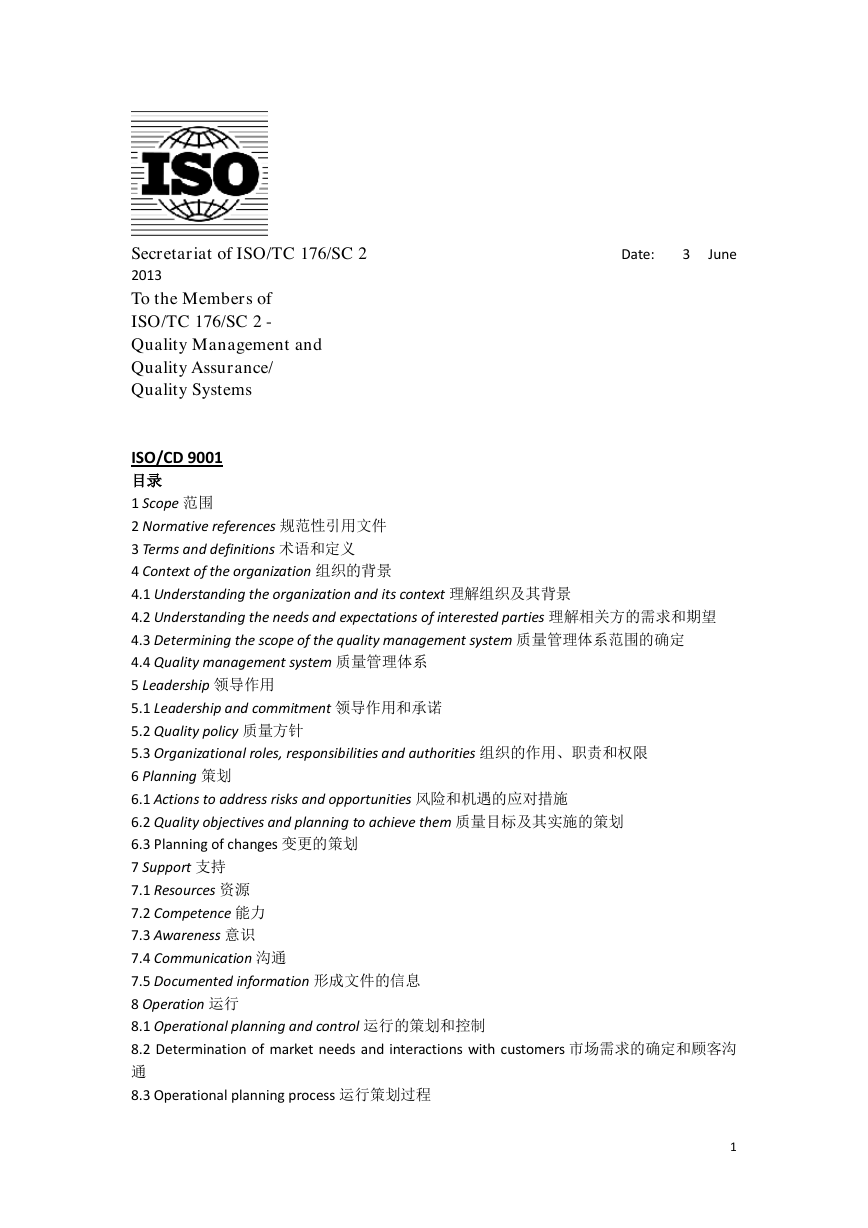
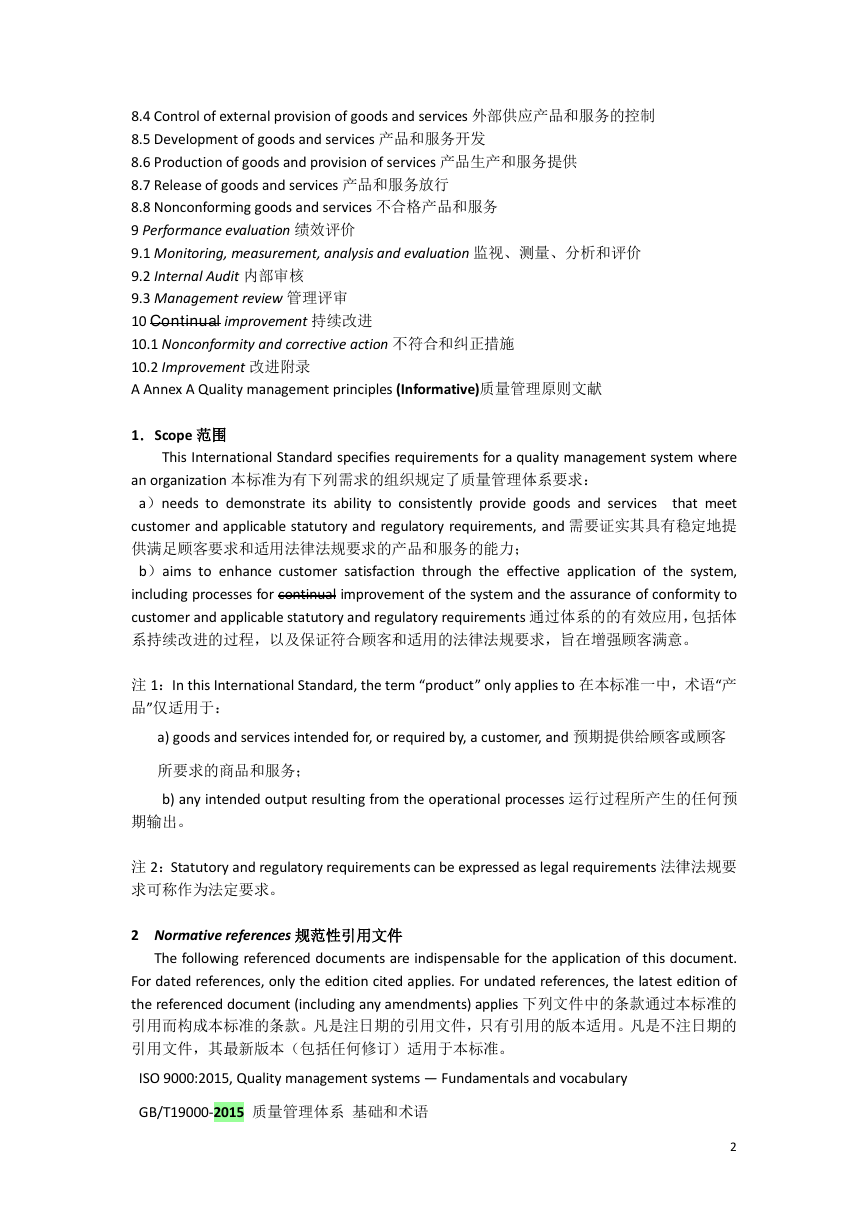
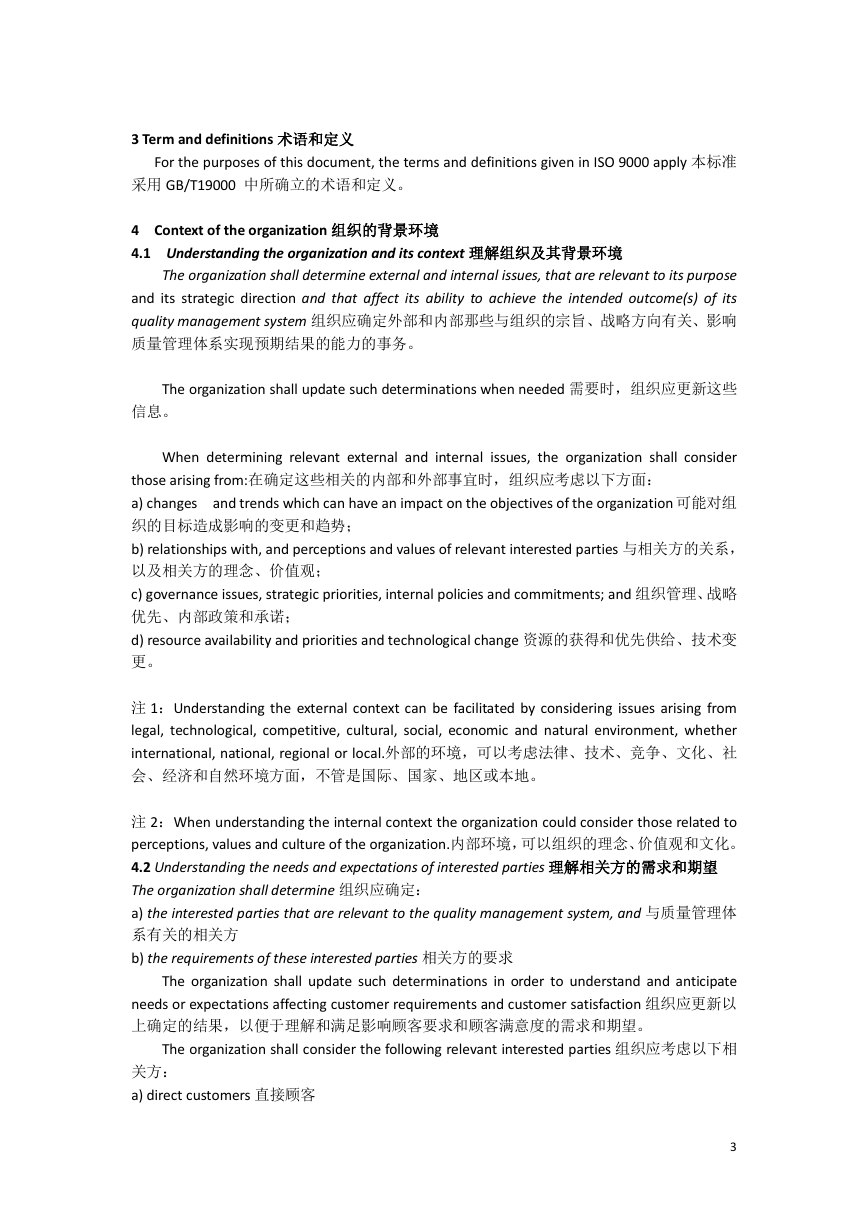
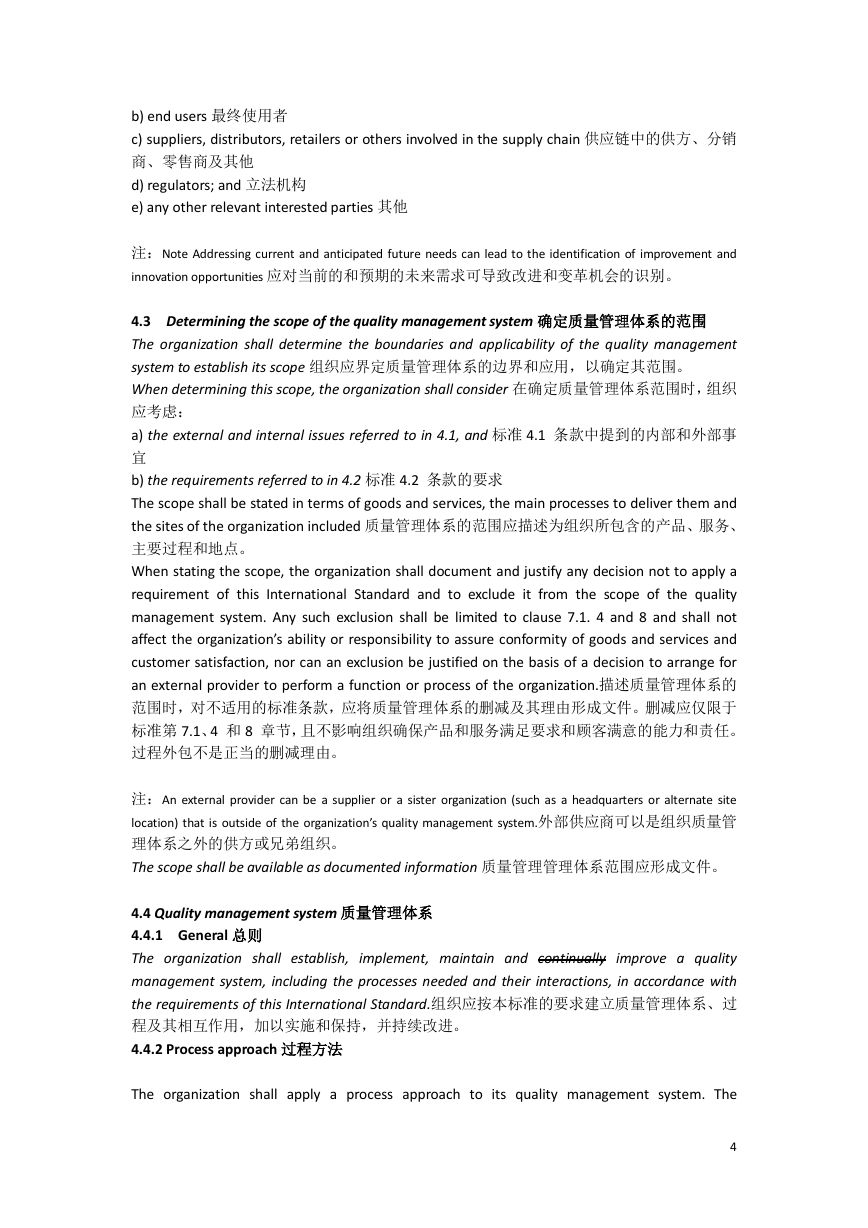
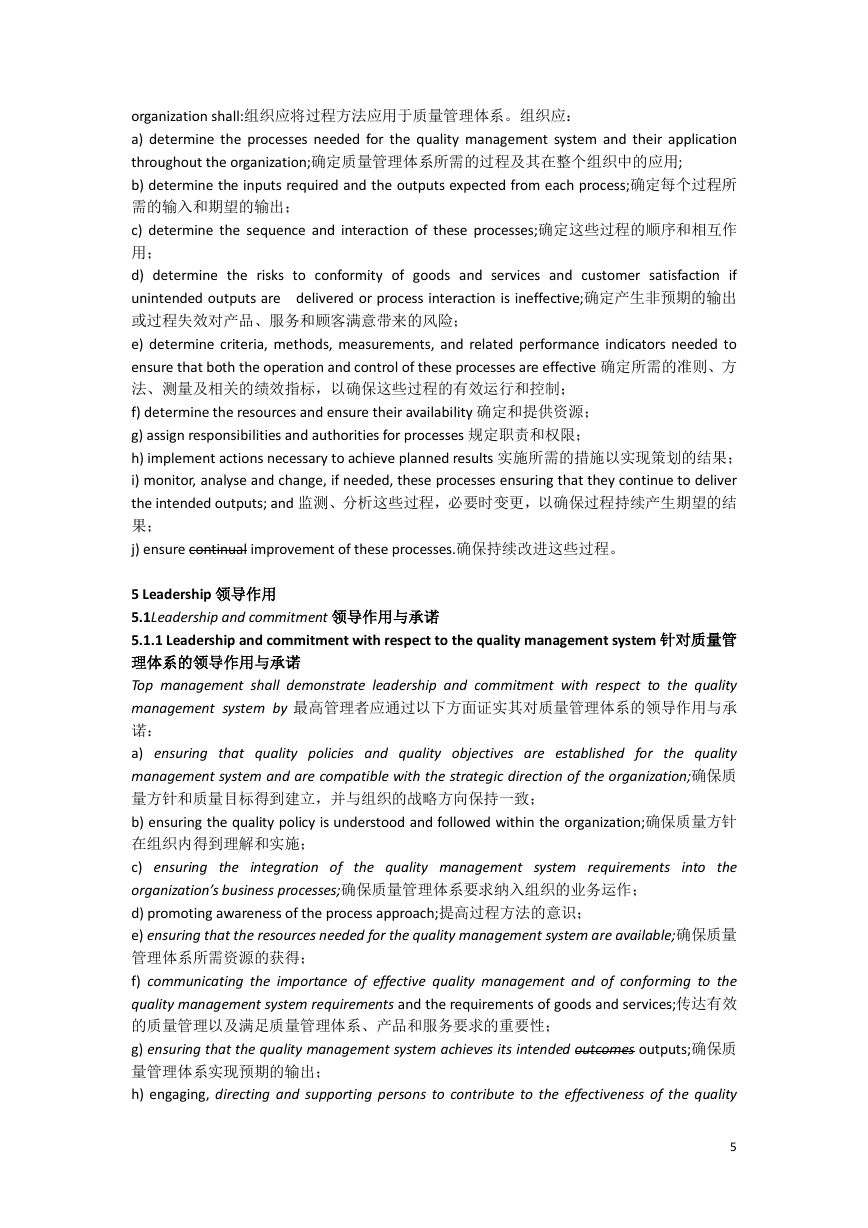

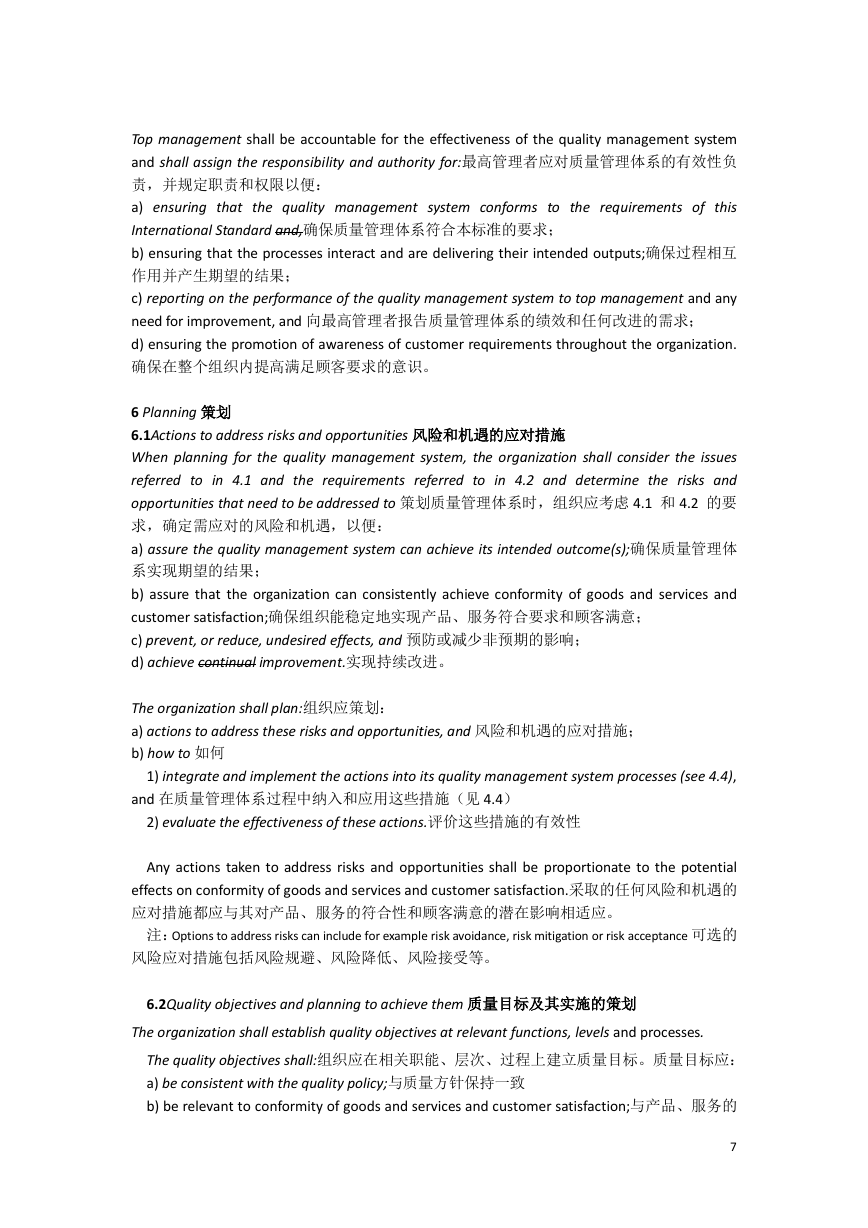









 2023年江西萍乡中考道德与法治真题及答案.doc
2023年江西萍乡中考道德与法治真题及答案.doc 2012年重庆南川中考生物真题及答案.doc
2012年重庆南川中考生物真题及答案.doc 2013年江西师范大学地理学综合及文艺理论基础考研真题.doc
2013年江西师范大学地理学综合及文艺理论基础考研真题.doc 2020年四川甘孜小升初语文真题及答案I卷.doc
2020年四川甘孜小升初语文真题及答案I卷.doc 2020年注册岩土工程师专业基础考试真题及答案.doc
2020年注册岩土工程师专业基础考试真题及答案.doc 2023-2024学年福建省厦门市九年级上学期数学月考试题及答案.doc
2023-2024学年福建省厦门市九年级上学期数学月考试题及答案.doc 2021-2022学年辽宁省沈阳市大东区九年级上学期语文期末试题及答案.doc
2021-2022学年辽宁省沈阳市大东区九年级上学期语文期末试题及答案.doc 2022-2023学年北京东城区初三第一学期物理期末试卷及答案.doc
2022-2023学年北京东城区初三第一学期物理期末试卷及答案.doc 2018上半年江西教师资格初中地理学科知识与教学能力真题及答案.doc
2018上半年江西教师资格初中地理学科知识与教学能力真题及答案.doc 2012年河北国家公务员申论考试真题及答案-省级.doc
2012年河北国家公务员申论考试真题及答案-省级.doc 2020-2021学年江苏省扬州市江都区邵樊片九年级上学期数学第一次质量检测试题及答案.doc
2020-2021学年江苏省扬州市江都区邵樊片九年级上学期数学第一次质量检测试题及答案.doc 2022下半年黑龙江教师资格证中学综合素质真题及答案.doc
2022下半年黑龙江教师资格证中学综合素质真题及答案.doc